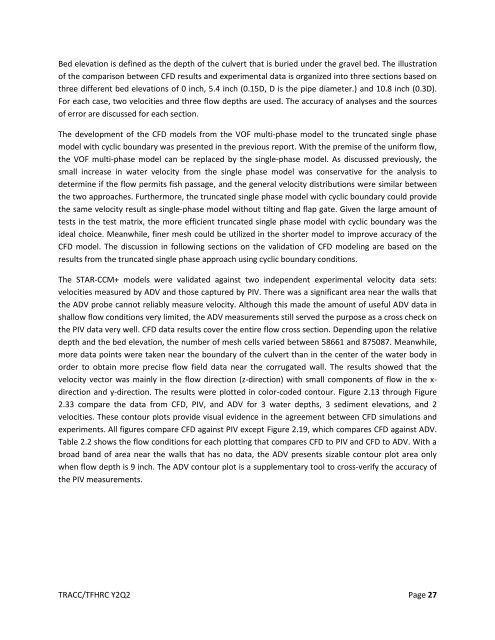Computational Mechanics Research and Support for Aerodynamics ...
Computational Mechanics Research and Support for Aerodynamics ...
Computational Mechanics Research and Support for Aerodynamics ...
- No tags were found...
Create successful ePaper yourself
Turn your PDF publications into a flip-book with our unique Google optimized e-Paper software.
Bed elevation is defined as the depth of the culvert that is buried under the gravel bed. The illustration<br />
of the comparison between CFD results <strong>and</strong> experimental data is organized into three sections based on<br />
three different bed elevations of 0 inch, 5.4 inch (0.15D, D is the pipe diameter.) <strong>and</strong> 10.8 inch (0.3D).<br />
For each case, two velocities <strong>and</strong> three flow depths are used. The accuracy of analyses <strong>and</strong> the sources<br />
of error are discussed <strong>for</strong> each section.<br />
The development of the CFD models from the VOF multi-phase model to the truncated single phase<br />
model with cyclic boundary was presented in the previous report. With the premise of the uni<strong>for</strong>m flow,<br />
the VOF multi-phase model can be replaced by the single-phase model. As discussed previously, the<br />
small increase in water velocity from the single phase model was conservative <strong>for</strong> the analysis to<br />
determine if the flow permits fish passage, <strong>and</strong> the general velocity distributions were similar between<br />
the two approaches. Furthermore, the truncated single phase model with cyclic boundary could provide<br />
the same velocity result as single-phase model without tilting <strong>and</strong> flap gate. Given the large amount of<br />
tests in the test matrix, the more efficient truncated single phase model with cyclic boundary was the<br />
ideal choice. Meanwhile, finer mesh could be utilized in the shorter model to improve accuracy of the<br />
CFD model. The discussion in following sections on the validation of CFD modeling are based on the<br />
results from the truncated single phase approach using cyclic boundary conditions.<br />
The STAR-CCM+ models were validated against two independent experimental velocity data sets:<br />
velocities measured by ADV <strong>and</strong> those captured by PIV. There was a significant area near the walls that<br />
the ADV probe cannot reliably measure velocity. Although this made the amount of useful ADV data in<br />
shallow flow conditions very limited, the ADV measurements still served the purpose as a cross check on<br />
the PIV data very well. CFD data results cover the entire flow cross section. Depending upon the relative<br />
depth <strong>and</strong> the bed elevation, the number of mesh cells varied between 58661 <strong>and</strong> 875087. Meanwhile,<br />
more data points were taken near the boundary of the culvert than in the center of the water body in<br />
order to obtain more precise flow field data near the corrugated wall. The results showed that the<br />
velocity vector was mainly in the flow direction (z-direction) with small components of flow in the x-<br />
direction <strong>and</strong> y-direction. The results were plotted in color-coded contour. Figure 2.13 through Figure<br />
2.33 compare the data from CFD, PIV, <strong>and</strong> ADV <strong>for</strong> 3 water depths, 3 sediment elevations, <strong>and</strong> 2<br />
velocities. These contour plots provide visual evidence in the agreement between CFD simulations <strong>and</strong><br />
experiments. All figures compare CFD against PIV except Figure 2.19, which compares CFD against ADV.<br />
Table 2.2 shows the flow conditions <strong>for</strong> each plotting that compares CFD to PIV <strong>and</strong> CFD to ADV. With a<br />
broad b<strong>and</strong> of area near the walls that has no data, the ADV presents sizable contour plot area only<br />
when flow depth is 9 inch. The ADV contour plot is a supplementary tool to cross-verify the accuracy of<br />
the PIV measurements.<br />
TRACC/TFHRC Y2Q2 Page 27

















